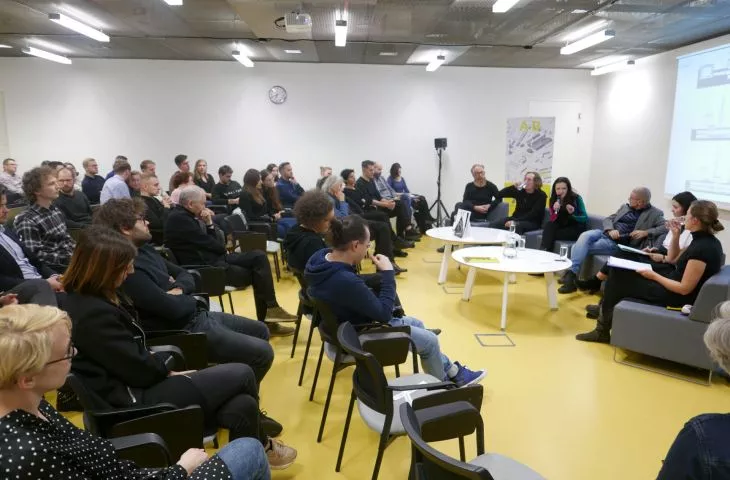On December 3, we met with Silesian architects at the Silesian Museum in Katowice to discuss the contemporary architecture of the Upper Silesian region. The debate was so heated, important and interesting that we far exceeded the museum's scheduled time, but it was worth it. What came out of the meeting? See for yourself!
Silesia is not only Katowice
The idea of the debate under the title "Contemporary Architecture of Upper Silesia" was a "round table" meeting, in which not only the panelists - Alicja Knast (director of the Silesian Museum), Robert Konieczny (KWK Promes), Przemo Łukasik (medusa group), Oskar Grąbczewski (OVO Grąbczewscy Architekci) and the representatives of A&B - Malgorzata Tomczak (editor-in-chief) and Katarzyna Jagodzinska (lecturer at the Institute of European Studies at the Jagiellonian University), but also all invited guests, including Joanna and Wojciech Mal ecki from the Malecki Design Office, Karol Wawrzyniak from the Toprojekt studio, Krzysztof Zalewski from the Zalewski Architecture Group, Piotr Sredniawa, and participants interested in the topic.
participants in the debate
Photo: Dobrawa Bies © A&B
When thinking of Silesia, Katowice is often the first thing that comes to mind. However, it should be remembered, as the debaters repeatedly reminded us, that Silesia is not only Katowice. Przemo Lukasik even added that the strength of Upper Silesia is precisely the effect of a mega-city with a developed infrastructure that connects, develops and opens up the agglomeration.
old vs. new
It was impossible, being at the Silesian Museum, not to devote part of the meeting to the development of Katowice's Culture Zone, thanks to which, as Oskar Grąbczewski noted, a certain fashion for the city could be observed. Referring to the discussion taking place around the space adjacent to the museum, Katarzyna Jagodzińska, co-host of the debate, raised the issue of cultural heritage, asking what to protect in Silesia as it is, what to creatively transform, and what to give up to make room for the new?
Although there is no clear answer to these questions, those who took the floor in the discussion pointed to the need for cultural competence to realize what we give up when we decide to transform post-industrial buildings, a certain sentimentalism prevalent in Silesia intowards purely industrial architecture, which, although it was not designed as an urban premise or a compositional element, but functional objects, is now protected like historic fabric, and the need to value the quality and usefulness of individual buildings with awareness and culture.
search for a common denominator
One of the main topics of discussion was Silesian identity and what unites artists who come from the Silesian school of architecture. A tag cloud was displayed during the meeting, depicting the most frequently mentioned terms used by architects to describe the local community in the June issue of A&B. What's more, the debate featured such buzzwords as right angle, minimalism, simplicity, honesty, morality, pragmatism, moderation, rationality, tradition, tolerance, affection, courage and openness.
Debate participants, from left: Oskar Grąbczewski of OVO Grąbczewscy Architekci, Alicja Knast - director of the Silesian Museum,
Robert Konieczny - head of the KWK Promes office, Małgorzata Tomczak - editor-in-chief of A&B
and Katarzyna Jagodzinska - editor of A&B and lecturer at the Institute of European Studies at the Jagiellonian University against the background of the tag cloud
Photo: Dobrawa Bies © A&B
Alicja Knast, director of the museum, pointed out that there is no single identity in Silesia, and that the common denominator of Silesians cannot be reduced to "roulade and noodles" for Sunday dinner. Rather, in her opinion, the common denominator of the region's residents comes out of vision and courage.
Oskar Grąbczewski added that "Silesianness" lies not in the fact that there is a certain architectural idiom, but in the fact that, working according to ethical principles - diligently, modestly and with engineering passion - local architects strive to create something the world has not yet seen.
challenges
One of the issues that arose during the debate was the inadequacy of tools such as urban planning and the Local Plan to the situation of the Silesian agglomeration. These issues steered the discussion participants onto the tracks of difficult social problems related to the effects of deindustrialization, such as apathy, depression and self-exclusion. As Piotr Średniawa stressed, Silesia must be viewed through a social prism, and the challenges facing the region include the exodus of young people and difficulties in developing strategies for certain areas.
What's next?
Neither Silesia nor Silesians, let alone the architecture there, can be described in a few words. However, solutions must be constantly sought, discussed and interdisciplinary teams must be formed to address the greatest challenges facing this great region and the outstanding architects operating there.
It was a wise, informative and fruitful discussion. We also recommend your attention to the video of the event, which was prepared by architects from Zalewski Architecture Group.
Once again, we thank the organizers and all the participants of the debate. See you there!







































































